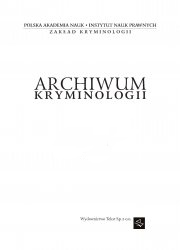FUNKCJONOWANIE „BIAŁYCH KOŁNIERZYKÓW” W WARUNKACH IZOLACJI PENITENCJARNEJ
‘White Collars’ in Penitentiary Isolation: A Case Study
Author(s): Monika KotowskaSubject(s): Law, Constitution, Jurisprudence, Criminal Law
Published by: Instytut Nauk Prawnych PAN
Keywords: izolacja penitencjarna;white collar crime;kryminologia;
Summary/Abstract: ‘White collars’ are perpetrators who do not fit the image of a ‘typical criminal’. They are often esteemed and enjoy a high position in society, while their crimes are part of the professional sphere and often occur ‘on the margins’ of legal activity. They also include people who – unlike ordinary criminals – risk losing their prestige, reputation and professional position. Their criminal activity is often seen as a mistake or omission, rather than as an intentional violation of the law. It would seem that ‘white collars’ are not a large group and that their crimes are not easily detected. They are not viewed as dangerous offenders who should be isolated. This is due to their personal traits, their modus operandi and the nature of their crimes, particularly as the latter are hard to detect, as well as to the fact that they have better access to high-quality legal aid than their less educated and wealthy counterparts. In prison, ‘white collars’ form a group which is difficult to define because of their small number. However, taking into account that Poland has seen a drop in the number of criminal offense in recent years, with a concomitant rise in the number of economic crimes, the number of ‘white collars’ in penitentiary facilities will surely grow steadily, particularly if a punitive criminal policy is pursued. From the viewpoint of criminal science, ‘white collars’ remain an unstudied phenomenon in Poland. Nor are there any studies of how ‘white collars’ cope with the conditions of life in prison. Looking for answers to these questions, the Author approached the authorities of one of the largest (the third in size) penitentiary facilities in the Olsztyn region with a request to access the prison archives. She examined the archival prison records of individuals who had served a sentence of imprisonment between 2005 and 2015 in order to identify a group of ‘white collars’. The selection criteria were as follows:- Final conviction for an economic crime/crimes- The crime was committed in connection with the person’s professional activity- Holders of a university/higher degree - Having a stable legal source of income.Individuals fulfilling the above criteria were considered as belonging to the category of ‘white collars’. It was found that during the period in question only two inmates detained at the facility matched the criteria, which justified further qualitative research. A case study was then conducted based on the archival personal records, parts A and B, which the prison made available to the Author. The Author looked specifically at documents like court sentences along with their justification, parole decisions made by penitentiary courts, probation reports, psychological opinions, as well as notes compiled by the inmates’ supervisors based on conversations with them. Because both of the inmates were serving their sentences within the framework of a programme system, the scope and nature of their personal programmes, including any updates, were also assessed. The records provided a glimpse into the perpetrators’ social and demographic status, including their financial and family status, as well as an overview of their previous life in society and, finally, in penitentiary conditions. The qualitative research undertaken by the Author did not make it possible to draw general conclusions, particularly since the cases studied were so few. But one can compare the studied perpetrators to the ‘statistical’ or ‘typical’ inmate doing time in prison. The literature on the subject indicates that most such inmates are single, young, unemployed, without work habits, they have gaps in their education, are alcohol or substance abusers and come from difficult homes. In prison, they lack external support, which makes their later social adaptation more difficult.The perpetrators studied as part of the research described here were much older and better educated than ‘typical’ convicts. They were relatively well-off, with stable incomes, and came from non-pathological homes. Their families were also evaluated positively by probation services, the police and neighbours. Before their stay in prison they had been involved in community initiatives, they were good husbands and fathers, active in the local community and the Church, without alcohol or substance abuse problems. While serving their sentences they received support from family and figures of authority esteemed in the local community. The Prison Service considered them well adapted to prison conditions, calm, often rewarded, obeying the rules, active, highly respected by other inmates, willingly performing unpaid work in behalf of the penitentiary facility and cooperating with the prison administration. The research material presented only represents two cases; it therefore does not make it possible to draw general conclusions, yet it does highlight certain problems and areas for further research. At the same time it is for the Author a point of departure for reflection on the legal and judicial level of sentences against ‘white collars’ and the way such sentences are enforced.
Journal: Archiwum Kryminologii
- Issue Year: 2017
- Issue No: XXXIX
- Page Range: 149-176
- Page Count: 28
- Language: Polish

